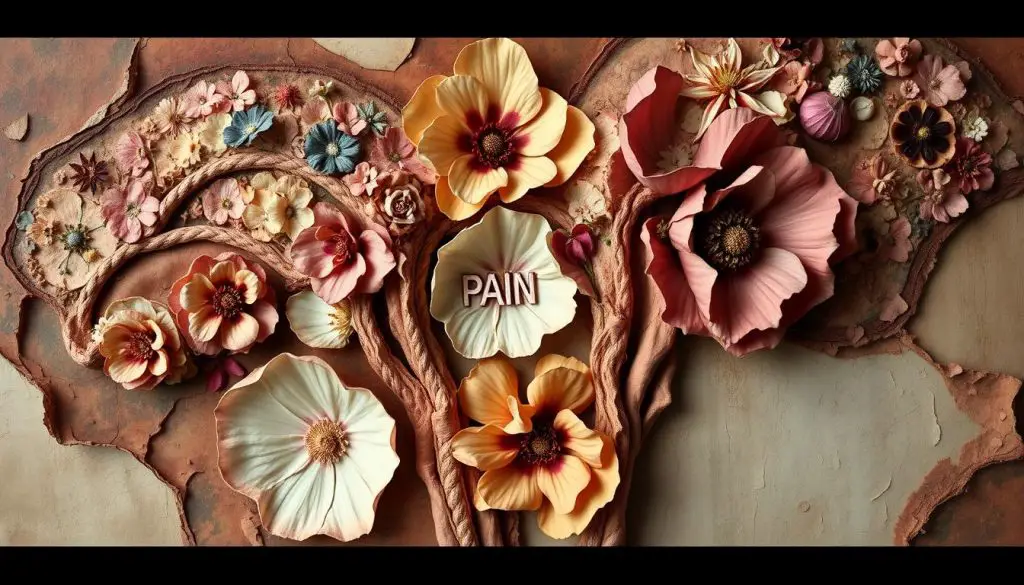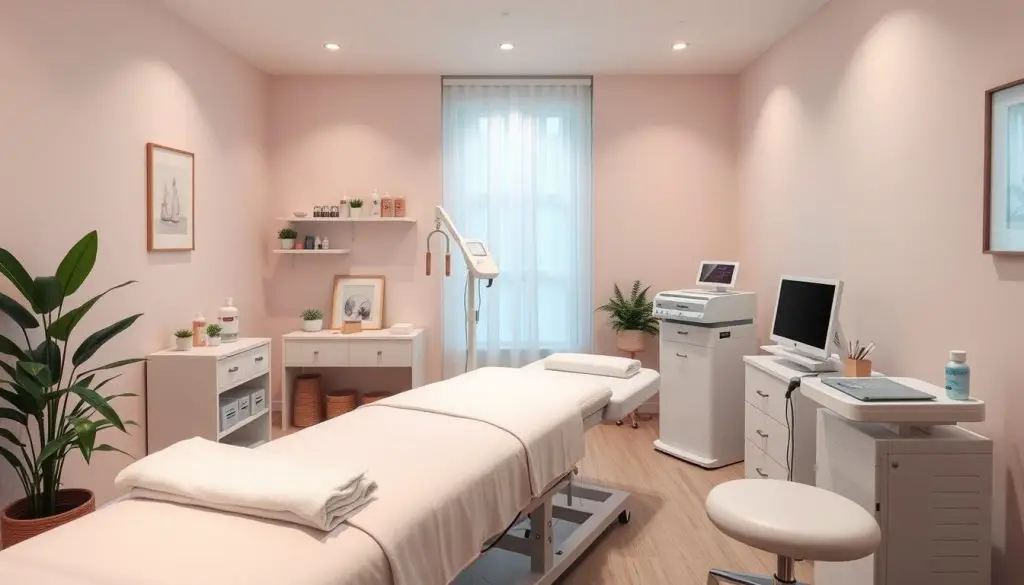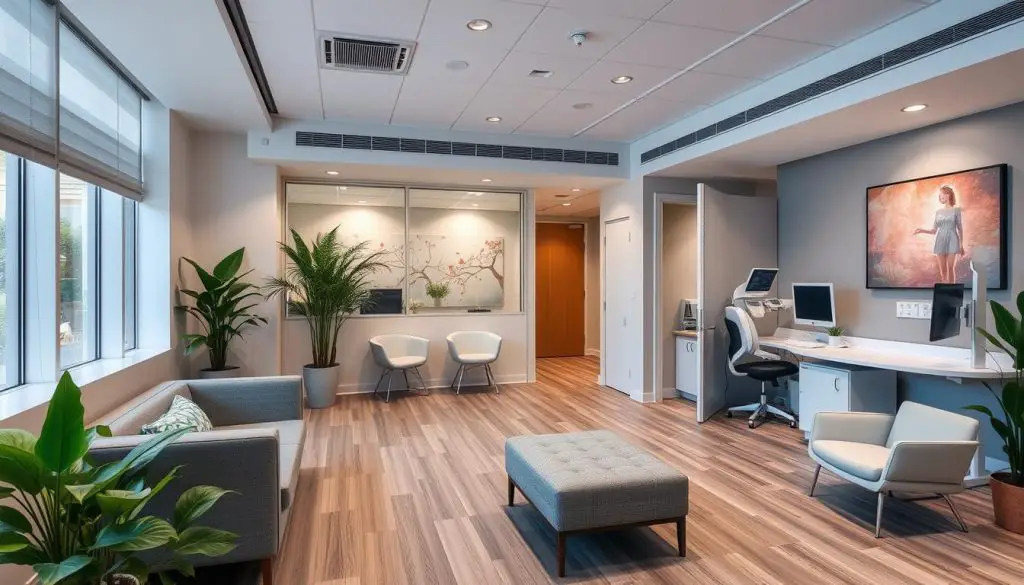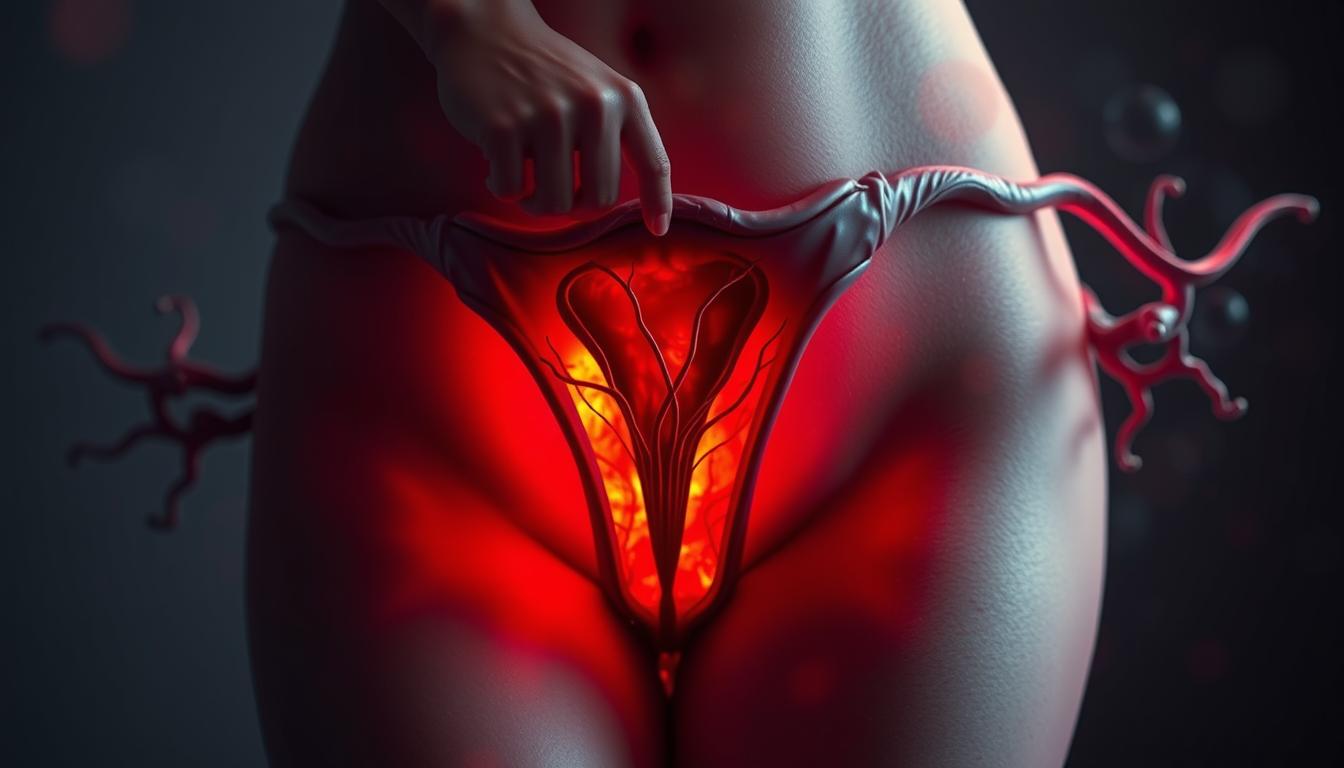Ever wondered why your menstrual cramps are so bad? They might be due to endometriosis. This condition affects about 1 in 10 people who menstruate. It makes the tissue inside the uterus grow outside, like on the ovaries or fallopian tubes.
When this tissue builds up and breaks down, it causes inflammation and scarring. This leads to severe menstrual cramps. If your cramps are so bad they stop you from doing daily things, you need to see a doctor. Painful periods could mean you have endometriosis.
What Is Endometriosis?
Endometriosis is a chronic, painful condition. It happens when tissue that lines the uterus grows outside the uterus. This tissue grows on other pelvic organs, like the ovaries and fallopian tubes. It can even grow on the bladder or intestines.
During the menstrual cycle, this tissue thickens, breaks down, and bleeds. But it can’t leave the body. This leads to inflammation, scarring, and adhesions. These adhesions cause severe pain and other symptoms.
Understanding the Condition
Endometriosis affects about 1 in 10 women during their reproductive years. The menstrual cycle lasts 21-35 days. Girls usually get their first period between 9-15 years old, with around 450-500 periods in a lifetime.
Symptoms include heavy menstrual bleeding and pelvic pain. These symptoms can be very uncomfortable.
Where Endometrial Tissue Grows
- Ovaries
- Fallopian tubes
- Bladder
- Intestines
The tissue outside the uterus acts the same as the lining inside. It thickens, breaks down, and bleeds with each cycle. But it can’t leave the body. This leads to inflammation, scarring, and adhesions. These cause severe pain and other symptoms.
Common Symptoms of Endometriosis
Endometriosis can cause severe symptoms that greatly affect a person’s life. The main symptoms include intense menstrual cramps, ongoing pelvic pain, and pain during sex.
Severe Menstrual Cramps
One key symptom of endometriosis is painful periods that are much worse than usual. People with endometriosis often have very bad menstrual cramps. These can start days before their period and get worse as it goes on.
Chronic Pelvic Pain
Endometriosis also causes chronic pelvic pain that lasts all month, not just during periods. This pain can make everyday activities hard and affect your quality of life a lot.
Pain During Intercourse
Another symptom is pain during sexual intercourse (dyspareunia). This happens because of endometrial tissue outside the uterus. It gets irritated and inflamed when you have sex.
While some people with endometriosis might not have symptoms, these three are the most common and severe. They include severe menstrual cramps, chronic pelvic pain, and pain during sex.
Why Are My Periods So Painful?
If you’re feeling severe menstrual cramps and pelvic pain during your period, it might be endometriosis. This condition happens when tissue like the uterine lining grows outside the uterus. It causes inflammation, scarring, and adhesions.
When this tissue builds up and breaks down during your period, it can’t leave your body. This leads to painful periods. The pain is often worse than usual menstrual cramps and can stop you from working or doing daily tasks.
Other issues like uterine fibroids, adenomyosis, pelvic inflammatory disease, and cervical stenosis can also cause painful periods. Starting puberty early, heavy bleeding, irregular periods, and a family history of painful periods can raise your risk too.
If your period pain is really bad and affects your daily life, talk to your healthcare provider. They can find out why you’re in pain and suggest treatments. This might include medicine, hormonal therapy, or surgery in some cases.
Ovarian Cysts and Endometriosis
For those with endometriosis, ovarian cysts called endometriomas or “chocolate cysts” often appear. These cysts form when endometrial tissue, misplaced in endometriosis, grows on the ovaries. As they grow, they can become very painful and may need to be surgically removed.
Ovarian cysts affect about 10 out of 100 women, with most being small, 1 to 3 centimeters. Usually, they go away on their own in a few months. But sometimes, they can grow up to 15 to 30 centimeters, causing serious problems like ovarian torsion, a very painful condition that might need surgery.
| Statistic | Value |
|---|---|
| Estimated prevalence of ovarian cysts | 10 out of 100 women |
| Typical size range of ovarian cysts | 1 to 3 centimeters |
| Potential maximum size of ovarian cysts | 15 to 30 centimeters |
| Incidence of ovarian torsion | Very rare |
Endometriosis-related ovarian cysts, known as endometriomas, are a common symptom. They can add to the pelvic pain people with endometriosis feel. Watching them closely and sometimes needing surgery can help manage these cysts and ease the pain.
Endometriosis and Infertility
If you’re struggling with endometriosis, you may also face the tough challenge of infertility. Endometriosis is a major cause of infertility, with 25-50% of women with infertility also having. This condition can affect your fertility in many ways.
Impact on Fertility
Endometriosis can harm your fallopian tubes and affect how eggs and sperm move. It can also lower the quality of your eggs. The scarring and inflammation from endometriosis make it hard for a fertilized egg to implant in your uterus.
For many women, treating the endometriosis can greatly improve their chances of getting pregnant. This includes the success of IVF (in vitro fertilization) procedures.
It’s key to work with a healthcare provider who knows a lot about endometriosis and infertility. They can help you create a treatment plan that tackles both issues. With the right care and support, you can overcome the challenges of endometriosis-related infertility and start a family.

Diagnostic Process for Endometriosis
Diagnosing endometriosis can be tough because symptoms vary. A laparoscopic surgery is usually needed to confirm it. This surgery involves a small incision and a thin, lighted camera to check the pelvic organs for endometrial tissue.
Laparoscopic Surgery
During the surgery, a biopsy sample is taken to confirm the diagnosis. Before surgery, doctors might do a pelvic exam, ultrasound, or MRI. These tests help understand the reproductive organs’ condition but can’t confirm endometriosis.
The laparoscopy is the best way to diagnose endometriosis. It lets the surgeon see the pelvic cavity and find any endometrial implants or adhesions. This info helps plan the right treatment to manage symptoms and protect fertility, if needed.
Being your own advocate is key when dealing with endometriosis. If you think you might have it, work with your doctor to find the right tests and procedures. This will help confirm the diagnosis and create a treatment plan just for you.
Treatment Options for Endometriosis
Living with endometriosis can be tough, but there are ways to manage it. First, doctors might try pain meds and hormone therapy. If these don’t work, surgery might be next.
Medication and Hormone Therapy
Pain medications like ibuprofen can ease menstrual cramps. Hormonal birth control can also help by stopping endometrial tissue growth. Progestin-only meds, like the LNG-IUS, are very effective after surgery.
Surgical Intervention
If meds and hormones don’t help, surgery might be needed. This is usually a laparoscopic procedure to remove endometrial tissue. But, in 20 out of 100 cases, the tissue can grow back within five years. There’s also a 1 in 100 chance of complications like organ injuries or infections.
For very bad cases, removing the uterus or ovaries might be suggested. But, this can cause early menopause, leading to hormone issues and health problems.
Some people try herbal remedies, diet changes, acupuncture, or relaxation techniques. While they might help, there’s no solid scientific proof they work well.
Finding the right treatment for endometriosis depends on many things. It’s important to work with a doctor to find what works best for you.

Coping with Endometriosis Pain
Dealing with the constant pain of endometriosis is tough. But, there are many ways to find relief. By making lifestyle changes and joining support groups, you can manage your symptoms better every day.
Lifestyle Changes
Making simple changes in your life can help a lot. Using heat therapy, like warm baths or heating pads, can ease cramps. Also, doing gentle exercises like yoga or walking can help by releasing endorphins and reducing inflammation.
Eating right is also important. Try to eat less processed food and more foods that fight inflammation. This can help with digestive problems too.
Support Groups
- Being part of an endometriosis support group, online or in person, is very helpful. You get emotional support and advice from people who know what you’re going through.
- Sharing your experiences and learning from others can make you feel less alone. It also makes you more confident in managing your health.
- Support groups are also a great place to learn about new research and treatments for endometriosis.
Managing endometriosis pain and its emotional effects needs a mix of approaches. By making lifestyle changes and getting support from others, you can take charge of your condition. This improves your life quality a lot.
Seeking Specialized Care
Women with endometriosis need to find gynecologists or pelvic pain specialists who know how to treat it. These doctors work in endometriosis centers, which are part of big hospitals. They have teams that use new surgery methods to help patients feel better.
Endometriosis Centers and Experts
Endometriosis centers offer full care for those with the condition. They have endometriosis specialists and pelvic pain specialists who know a lot about it. These doctors use the latest tools and minimally invasive surgery to find out how bad it is and make plans to help.
Going to an endometriosis center means getting help that looks at all parts of the condition. This includes managing pain, trying to keep fertility, and improving life quality. These places stay up-to-date with new research and treatments, giving patients the best care.

Women with endometriosis should ask for help from endometriosis specialists or pelvic pain specialists. Working with these experts helps patients manage their condition better. This way, they can improve their health and well-being.
Mental Health and Endometriosis
Living with endometriosis can really affect your mental health. Women with this condition often deal with more depression and anxiety than others. The pain, infertility issues, and other challenges can deeply hurt your emotional state, making it hard to get diagnosed.
Getting help from both mental health experts and endometriosis specialists is key. Endometriosis can make you feel isolated, frustrated, and out of control. Therapy, support groups, and self-care can help you cope better.
The link between endometriosis and mental health is complex. The pain and symptoms can lead to depression and anxiety. But, the emotional strain of the condition can also worsen the physical symptoms. Treating both mental and physical aspects is often the best way to manage endometriosis.
Remember, you’re not alone. Millions of women face endometriosis, and with the right support, you can manage it. This includes your mental health.
| Statistic | Value |
|---|---|
| Women with endometriosis who experience mild or high psychological stress | More than two-thirds (68%) |
| Women with endometriosis who are more likely to suffer from a mental health condition | Twice as likely |
| Women with endometriosis who experience suicidal thoughts or feelings | About 50% |
Endometriosis and Quality of Life
Endometriosis is a chronic condition that deeply affects a woman’s life. It causes severe pain that can stop daily activities, hurt work, and strain personal relationships. A study found that over 90% of women with endometriosis suffer from pelvic pain. Also, 80% face painful sex, and 75% deal with heavy bleeding.
The condition’s physical and emotional effects are severe. Women often feel chronic pain, fatigue, and struggle with infertility. These symptoms can make it hard to work or school and do everyday tasks. Research has found 33 unique ways endometriosis can harm a woman’s life quality.
It’s key to tackle endometriosis to improve well-being. Early diagnosis and effective treatment are vital. Being empathetic, patient, and understanding is also important for partners.
By spreading awareness and pushing for better healthcare, we can help those with endometriosis. Managing this condition is tough, but with support, women can overcome its challenges. They can live fully despite the illness.

Understanding Endometriosis Symptoms
Endometriosis is a chronic condition that affects about 1 in 10 individuals assigned female at birth. The main symptoms include severe menstrual cramps, chronic pelvic pain, and painful sex. Sometimes, symptoms don’t match the amount of endometrial tissue.
Some women with a lot of endometriosis may not feel much pain. Others with less may have severe pain. This makes endometriosis hard to diagnose and manage.
Women with endometriosis may also have bowel and bladder issues. These can include diarrhea, constipation, and painful urination, worse during their period. These symptoms can really affect a person’s life and well-being.
The term “endo” is short for endometriosis. It’s when tissue like the womb lining grows outside the uterus. This can cause inflammation, scarring, and adhesions, leading to severe symptoms.
If you’re dealing with bad menstrual cramps, pelvic pain, or painful sex, talk to a doctor. They can find out what’s causing your symptoms and help you get better.
Endometriosis and Bowel/Bladder Issues
Endometriosis can really affect your bowel and bladder, causing a lot of discomfort. The proteins from endometrial tissue can irritate the bladder and intestines. This leads to symptoms like nausea, diarrhea, constipation, and painful urination, worse during your period.
Many women with endometriosis also have irritable bowel syndrome (IBS). This makes their symptoms even worse. About 5 percent of women with endometriosis have it in their urinary system. And around 30 percent of those with bladder endometriosis don’t show any symptoms.
It’s key to manage both endometriosis and bowel or bladder issues together. Your doctor might suggest hormone therapy, surgery, or lifestyle changes. These can help ease your symptoms and improve your life quality.
Source Links
- https://nyulangone.org/news/endometriosis-six-symptoms-you-should-never-ignore
- https://www.endofound.org/painful-periods
- https://my.clevelandclinic.org/health/diseases/10857-endometriosis
- https://www.obgynassociatesmarietta.com/blog/normal-menstrual-cramps-or-endometriosis-how-to-tell-the-difference
- https://www.ohsu.edu/womens-health/severe-menstrual-pain-not-normal
- https://www.webmd.com/women/endometriosis/understanding-endometriosis-symptoms
- https://www.topdoctors.co.uk/medical-articles/know-difference-between-regular-period-pain-endometriosis
- https://www.hopkinsmedicine.org/health/conditions-and-diseases/endometriosis
- https://www.mayoclinic.org/diseases-conditions/menstrual-cramps/symptoms-causes/syc-20374938
- https://medlineplus.gov/periodpain.html
- https://www.ncbi.nlm.nih.gov/books/NBK539572/
- https://www.nhs.uk/conditions/ovarian-cyst/
- https://parkavefertility.com/infertility-causes/endometriosis/
- https://atriumhealth.org/dailydose/2024/03/05/story-about-endometriosis
- https://nyulangone.org/conditions/endometriosis/diagnosis
- https://www.brighamandwomens.org/obgyn/infertility-reproductive-surgery/endometriosis/endometriosis-symptoms
- https://www.healthline.com/health/womens-health/endometriosis-pain
- https://www.ncbi.nlm.nih.gov/books/NBK279498/
- https://www.webmd.com/women/endometriosis/ss/slideshow-unexpected-ways-to-ease-endometriosis-pain
- https://www.healthline.com/health/womens-health/endometriosis-pain-relief
- https://www.ncbi.nlm.nih.gov/books/NBK279502/
- https://www.uptodate.com/contents/painful-menstrual-periods-dysmenorrhea-beyond-the-basics/print
- https://www.medicalnewstoday.com/articles/unbearable-period-pain
- https://www.nhs.uk/conditions/period-pain/
- https://www.healthdirect.gov.au/painful-periods
- https://www.psychiatry.org/news-room/apa-blogs/how-endometriosis-can-impact-mental-health
- https://www.drdanielkushner.com/blog/how-does-endometriosis-impact-mental-health
- https://www.ncbi.nlm.nih.gov/pmc/articles/PMC10241351/
- https://www.who.int/news-room/fact-sheets/detail/endometriosis
- https://livehealthy.muhealth.org/stories/period-pain-6-surprising-facts-know-about-endometriosis
- https://theconversation.com/i-have-painful-periods-could-it-be-endometriosis-101026
- https://www.healthline.com/health/painful-menstrual-periods
- https://news.llu.edu/health-wellness/menstrual-cramps-or-endometriosis-signs-and-symptoms-look-out-for
- https://www.bladderandbowel.org/associated-illness/endometriosis/
- https://www.healthline.com/health/womens-health/bladder-endometriosis
- https://www.orlandohealth.com/services-and-specialties/orlando-health-womens-institute/content-hub/learn-the-difference-between-painful-periods-endometriosis-and-ibs/
